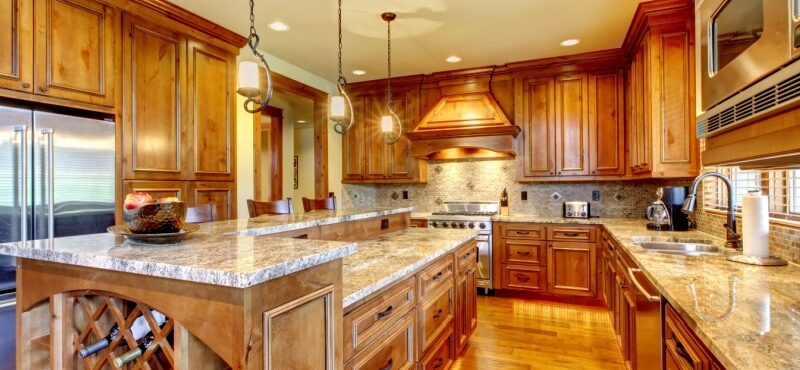Granite countertops are a beautiful and durable addition to any kitchen or bathroom, adding both value and style to your home. Known for their natural elegance and resilience, granite countertops can last a lifetime with the right care. However, to ensure they maintain their luster and continue to stand the test of time, proper maintenance is essential. In this guide, we’ll cover the best practices for cleaning, sealing, and maintaining your granite countertops so that they remain as stunning as the day they were installed.
Daily Cleaning Tips
The key to maintaining granite’s beauty is to use the right cleaning products. Avoid harsh, abrasive cleaners and opt for pH-balanced, granite-specific products or simple dish soap mixed with warm water. Wipe the surface with a soft cloth or sponge to remove dirt and spills without damaging the granite.
Citrus-based or acidic cleaners, such as vinegar and lemon juice, can potentially damage the protective sealant on granite after a while and can also cause etching. These substances may weaken the surface over time, making it prone to stains and dulling the finish.
After you wipe down your countertops when cleaning, use a soft, dry cloth to buff the surface dry. This helps prevent potential water spots or streaks and keeps the granite looking polished and pristine.
Sealing Your Granite Countertops
Importance of Sealing: Granite is a porous natural stone, which means it can absorb liquids and become stained if not properly sealed. Sealing your granite countertops helps create a protective barrier, making them more resistant to spills and stains.
How Often Should You Seal? The frequency of sealing depends on the type of granite and the amount of use your countertops get. In general, sealing should be done at least once a year, but some high-quality sealants can last longer. To determine if your countertop needs resealing, conduct a simple water test: place a few drops of water on the surface. If the water beads up, the seal is intact. If it soaks into the stone and leaves a dark spot, it’s time to reseal.
How to Seal Granite: Before sealing your granite, ensure the surface is clean and completely dry. Using a clean, soft cloth or sponge, evenly apply a granite-specific sealant according to the manufacturer’s instructions. Allow the sealant to sit for the recommended time, typically 15-20 minutes, so it can penetrate the surface. Once the time has passed, use a clean cloth to wipe away any excess sealant to achieve an even finish. It’s important to let the sealant cure for about 24 hours before using the countertop to ensure full protection.
Stain Prevention and Removal
One of the best ways to prevent stains on granite countertops is to clean up spills immediately. Spilled liquids like wine, coffee, and oil can seep into the stone if left for too long, resulting in unsightly stains.
Dealing with Stains
If you do find a stain on your granite countertop, there are ways to treat it effectively:
- Oil-Based Stains: Create a paste with baking soda and water, apply it to the stained area, and cover it with plastic wrap. Let it sit for a few hours or overnight, then wipe away the paste and rinse with water.
- Water-Based Stains: Mix hydrogen peroxide with a few drops of ammonia and apply it to the stain. Let it sit for a few minutes, then rinse and dry thoroughly.
Avoid Harsh Stain Removers
While it may be tempting to use bleach or other harsh chemical cleaners on a stain, these can damage the sealant and etch the surface. Always use granite-safe stain removers or natural cleaning solutions for stain treatment.
Protecting Your Granite Countertops
Use Coasters and Trivets: Even though granite is heat-resistant, sudden temperature changes from placing hot pots or pans directly on the surface can cause thermal shock and lead to cracking. Always use trivets or heat pads to protect your granite from extreme heat. Coasters help prevent water rings and etching from acidic drinks.
Avoid Cutting Directly on the Surface: Although granite is highly durable, cutting directly on the countertop can dull your knives and potentially scratch the sealant. Always use a cutting board to protect both your knives and your granite’s surface.
Maintaining Shine and Longevity
Polishing Your Granite
Regular polishing can help maintain the natural shine of granite countertops. Use a granite-specific polish to enhance the surface’s gloss and help maintain the seal. Apply polish according to the manufacturer’s instructions, typically every few weeks or as needed.
Routine Inspections
Periodically check your countertops for any signs of damage, such as chips or cracks, and address them promptly. Small chips can often be repaired with a clear epoxy, while deeper damage may require professional help.
Protect Your Granite Investment
Granite countertops are a beautiful, durable investment that can last for decades if properly maintained. By following these simple care practices—such as using the right cleaning products, sealing regularly, and protecting the surface from heat and stains—you can keep your granite looking its best.
At Tops Kitchen Cabinet, we offer wholesale granite countertops that are both high-quality and affordable, making it easier for you to enjoy this timeless material in your kitchen. For more information or personalized advice on maintaining your granite countertops, contact us today!

